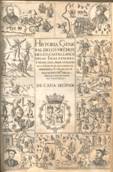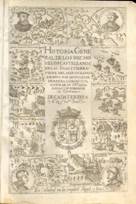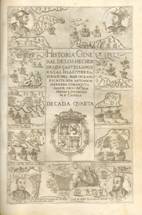larger image 705KBAntonio De Herrera
A professional man of letters, Antonio de Herrera y Tordesillas of Castile was born in 1549, educated in Italy in the traditions of Italian humanism, a secretary of viceroys, historian and translator. He was appointed Cronista Mayor de las Indias (Royal Historiographer of the Indies) by King Philip II of Spain in 1596, primarily to write the official history of the Spanish adventure in the New World. He had to his credit, before this lucrative appointment, an impressive range of published works including translations of Italian political theory. Heir to the Italian humanist tradition of universal history, Herrera also wrote a history of the world, which, despite its pretentious title, was actually limited to chronicling the events of the reign of Phillip II of Spain. With his General History of the West Indies (sometimes referred to as ‘the Decades', the sections into which it was divided) his most famous and influential work, Herrera established a truly “Imperial” school of New World History, modeled on the classical historians Tacitus and Suetonius, a paean to universal imperial rule, and in the case of Counter Reformation Spain, with the added mission of Christianizing the New World in the Catholic faith. Herrera remained in this office of ‘chief historiographical chronicler of the Indies ' until his death in 1625 having served three Spanish kings.
larger image 980KBHerrera never visited the New World but had unprecedented access to official archives: correspondence, accounts, reports, journals, and histories, (the famous ‘Relaciones' –of which those of the Jesuits are the most familiar to us in their multi-volume printed set) both manuscript and published of all the participants of the conquest, soldiers, adventurers and missionaries, who had written voluminously of themselves and what they did and what they saw. As such it was more than the story of conquest; it was also travel account as well as natural and ethno- history. Herrera was stereotypically Eurocentric and imperialist in outlook, but the description of people and cultures as well as the land itself are from eyewitness accounts of sometimes educated and sensitive observers. Herrera's compilation was the most authoritative of it's time and included accounts which had not been published and which have since disappeared.
larger image 931KBHe published his mammoth history in two parts, the first part in 1601 and the second part in 1615. Herrera originally ended his history at 1554 when Peru was pacified; what happened later (which was little) he had already included in his history of the reign of Phillip II. Herrrera's project was initiated in 1571 with the sending out of ‘ cedulas ' – questionnaires - asking the various colonial officials for information and to turn over their papers. Herrera also included manuscript material prepared by his predecessor, royal cosmographer Juan Lopez de Valasco, which included fourteen maps. While Valasco, like Herrera, was a assiduous collector and compiler of contemporary information and like Herrera utilized imperial bureaucracy to send out a series of questionnaires and surveys, his cartographic report, Geografía y descripción universal de las Indias, presented to the Council of the Indies in 1574 was already dated, and by the time Herrera published it in his Decades it was anachronistic. The maps and descripción are an interesting feature of Herrera's volumes but were not an accurate reflection cartographic knowledge of the New World in 1601.
Home | Introduction | Decades 5 - 7 | Decade 8 | WDS Home page


